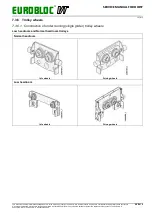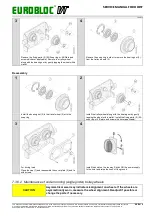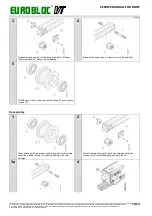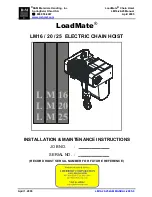
EUROBLOC
SERVICE MANUAL FOR HOIST
211/212
This document and the information contained herein, is the exclusive property of Verlinde S.A.S. and represents a non-public, confidential and proprietary trade secret that
may not be reproduced, disclosed to third parties, altered or otherwise employed in any manner whatsoever without the express written consent of Verlinde S.A.S.
Copyright © (2013) Verlinde S.A.S. All rights reserved.
06/2015
8.2
Disposal of Waste Material
Waste material from installation, maintenance or dismantling shall be handled and disposed of according to local
regulations. From the sustainability point of view, the preferred waste handling methods are reuse, recycle as
material, recycle to energy, and as a final resort, safe disposal.
As waste regulations and types of recovery and disposal methods vary so much regionally, no general detailed
guidance can be given. The chart below gives example of manufacturer’s proposals for adequate waste handling
methods.
NOTICE
Use always licensed recycling companies.
1
Metals should be recycled.
2
Electronics and electromechanical components should be collected separately and recycled.
Some electrical parts may be treated as hazardous waste, e.g. standard fluorescent lamps contain
mercury.
3
Batteries and other energy storage components may contain hazardous substances. These items
should be collected separately and recycled according to local regulations.
4
Plastics should be either recycled as material or used for energy recovery or landfilled. PVC
plastic should be recycled according to local regulations.
5
Chemicals, like oil, grease and other liquids shall never be spilled onto the ground, soil or
sewage. Waste oil and grease shall be stored in containers indicated for the purpose. More
detailed information of chemical handling as waste can be found in the chemical’s Safety Data
Sheet that is available from manufacturer of the chemical.
6
Packing materials, like plastics, wood and cardboard, should be reused or recycled as material or
to energy.


























